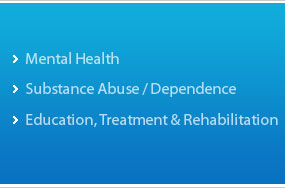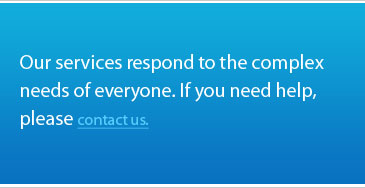Services
At MPC, we offer a broad spectrum of outpatient services using the latest evidence-based approaches in a warm, comfortable environment treating others with proper respect and affirming dignity of our clients.
Mental Disorders
At MPC we treat several psychological/psychiatric disorders including but not limited to:
I. Major depression
II. Anxiety
III. Attention Deficit Hyperactivity Disorder (ADHD)
IV. Psychotic Disorders
V. Bipolar disorder
VI. Substance Abuse
I. Major depression
Depression is characterized by a combination of symptoms that interfere with various aspects of a person’s life. It can affect person’s ability to work, sleep, study, eat and enjoy once pleasurable activities. Some of these sypmtoms include:
- Feelings of unworthiness, guilt and/or helplessness
- Thoughts of suicide and death
- Difficulty in sleeping and concentrating
- Fatigue
Major depression is disabling and prevents a person from functioning normally. An episode of major depression may occur once in a person’s lifetime, but usually recurs throughout a person’s life.
Categories of Depression include:
- Dysthymic disorder (dysthymia), is characterized by less severe symptoms over a span of two or more years, that can prevent one from functioning normally, though not disabling a person. People with dysthymia may experience one or more episodes of major depression during their lifetime.
- Psychotic depression occurs when a severe depressive illness is accompanied by some form of psychosis, such as a break from reality or hallucinations.
- Postpartum depression is estimated to affect 10-15% of women after a new mother gives birth. It can be diagnosed within one month of giving birth, but onset can be delayed for several months.
- Seasonal Affective Disorder (SAD): characterized by the onset of depressive illness during the winter months, when there is less natural sunlight. The symptoms generally lift during spring and summer. SAD may be effectively treated with light therapy, but nearly half need the combination of antidepressant medication, psychotherapy and light therapy for effective treatment.
Back to Top
II. Anxiety
Anxiety disorders affect about 18% of adults age 18 years and older every year. Those with an anxiety disorder feel fearful and uncertainty with symptoms that last at least 6 months and can get worse if not treated. Anxiety disorders commonly occur with other mental or physical illnesses such as alcohol or substance abuse, which may mask anxiety symptoms or make them worse. In some cases, these other illnesses need to be treated before a person will respond to treatment for the anxiety disorder.
Categories of anxiety disorders include:
- Panic disorder: to suffer from recurrent episodes of panic attacks which are unexpected and unpredictable. A panic attack is defined as a discrete period of intense fear or discomfort, with four or more of the following symptoms developed abruptly and reached a peak within 10 minutes:
- Chills or hot flushes
- Palpitations, pounding heart or accelerated heart rate
- Paresthesias (numbness or tingling sensations)
- Sweating
- Trembling or shaking
- Sensations of shortness of breath or smothering
- Feeling of choking
- Fear of losing control or going crazy
- Chest pain or discomfort
- Nausea or abdominal stress
- Obsessive-Compulsive Disorder (OCD) is a combination of obsessions and compulsions where in obsessions; a person has recurrent, persistent thoughts, images or impulses that are experienced as intrusive and inappropriate. Compulsions are repetitive behaviors (e.g., hand washing) or mental acts (e.g., counting, repeating words) that the person feels driven to perform in response to an obsession or according to rigid rules. The person recognizes that the obsessions or compulsions are excessive or unreasonable.
- Post-Traumatic Stress Disorder (PTSD) is defined as a group of symptoms in response to a stressor. The symptoms persist for at least one month and include re-experiencing a traumatic event such as having nightmares, numbed feeling and symptoms of an increased level of arousal and avoidance of stimuli associated with the event.
- Social phobia (or social anxiety disorder) is a persistent, irrational fear accompanied by the desire to avoid situations of possible humiliation or embarrassment. The person recognizes the fear as excessive or unreasonable. Common social phobias involve fears of speaking or eating in public, urinating in public lavatories, writing in front of others or saying foolish things in social situations.
- Specific phobias include strong fears of spiders, heights traveling on airplanes and being in crowds.
- Generalized Anxiety Disorder (GAD), in which excessive anxiety and worry occurs for several days in a span for at least 6 months, about a number of events or activities such as work or school performance. The person finds it difficult to control the worry. The anxiety and worry are associated with three or more of the following symptoms generally lasting most days for the past 6 months.
- Restlessness or feeling on edge
- Being easily fatigued
- Difficult concentrating or mind going blank
- Irritability
- Muscle tension
- Sleep disturbance (difficulty falling or staying asleep, or restless unsatisfying sleep)
Back to Top
III. Attention Deficit Hyperactivity Disorder (ADHD)
ADHD is one of the most common mental disorders that develop in children. Children with ADHD have impaired functioning in multiple settings, including home, school and in relationships with peers. If untreated, the disorder can have long-term adverse effects into adolescence and adulthood. Symptoms of ADHD occur over the course of many months and include: inattention (e.g., easily distracted, have difficult focusing), hyperactivity (e.g., have trouble sitting still during dinner, school and story time) and impulsivity (e.g., be very impatient, often interrupt conversations or others’ activities).
Back to Top
IV. Psychotic Disorders
Schizophrenia is a chronic and severe disorder characterized by a deteriorating ability to function in everyday life. About 1% of Americans have this illness, many have difficult holding a job or caring for themselves.
People with the disorder may hear voices other people don’t hear. They may believe other people are reading their minds, controlling their thoughts, or plotting to harm them. This can terrify people with the illness and make them withdrawn or extremely agitated.
People with schizophrenia may not make sense when they talk. They may sit for hours without moving or talking. Sometimes people with schizophrenia seem perfectly fine until they talk about what they are really thinking.
The symptoms of schizophrenia fall into three broad categories:
Positive symptoms, negative symptoms, and cognitive symptoms
Positive symptoms are psychotic behaviors in which they lose touch with reality. These symptoms can come and go. Sometimes they are severe and at other times hardly noticeable, depending on whether the individual is receiving treatment. They include:
- Hallucinations, which are things a person sees, hears, smells or feels that no one else experiences. Voices are the most common type of hallucination.
- Delusions are unusual or dysfunctional ways of thinking. Disorganized thinking is when a person has trouble organizing his or her thoughts or connecting them logically. They may talk in a garbled way that is hard to understand.
- Movement disorders may appear as agitated body movements, which is when a person repeats a certain motion over and over.
Negative symptoms are disruptions to normal behavior. These symptoms are harder to recognize and can be mistaken for depression or other conditions. These symptoms include:
- Flat affect (a person’s face does not move or he or she talks in a dull or monotonous voice)
- Lack of pleasure in everyday life
- Lack of ability to begin and sustain planned activities
- Speaking little, even when forced to interact
People with negative symptoms need help with everyday tasks. They often neglect basic personal hygiene. This may make them seem lazy or unwilling to help themselves, but the problems are symptoms caused by the schizophrenia.
Other psychotic disorders include: schizoaffective disorder, brief psychotic disorder, delusional disorder, substance-induced psychotic disorder and psychotic disorder due to a medication or general medical condition.
Back to Top
V. Bipolar disorder
Bipolar disorder is characterized by cycling mood changes from extreme highs (mania) to extreme lows (depression). Mania is described as restless activity, excitement, self-confidence, rambling speech and loss of inhibition. For more information on depression, see the section on major depression.
Back to Top
VI. Substance Abuse
Substance abuse is a disease in which a person misuses an illegal drug/Alcohol/ even some prescription medications and takes the drug(s) in excess. Abusing Alcohol or drugs leads to problems with everyday functioning, which can lead to health, legal and family issues.
Some commonly abused illegal drugs are:
Legal drugs that are used without a prescription or used improperly are:
- Narcotic painkillers. (Oxycontin, Vicodin, Percocet)
- Amphetamines/ Stimulants.
- Drugs that are used for treating anxiety (Benzodiazepines).
- Sleeping pills.
Back to Top
|




















